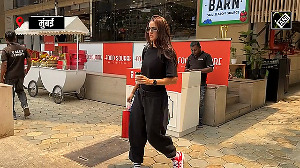Not far from Delhi, the orchards of Rataul offer a wide variety of mangoes, including one that rarely makes it to the market

I'm standing over a row of vats full of mangoes, hands sticky with their sweet juice, wondering whether to have another. "Come on... pick one! Life is too short to not have mangoes!" says a smiling stranger as she picks up the fruit. I smile and follow suit -- in Rataul, eating just one mango does seem sacrilegious.
Connoisseurs of the fruit consider this tiny town in Baghpat, Uttar Pradesh, as somewhat of a Mecca. Home to a mostly impoverished population of about 15,000, Rataul produces an elegant little mango that can hold out on its own against seasoned stalwarts like the langda, chausa and dussheri. Today, the stalwarts lie ignored in their vats, for the day clearly belongs to the Rataul. The men behind the vats offer me a perfectly ripened fruit (they call it daana here), saying, "Eat some more, Ratauls hardly ever make it to the markets of Delhi -- especially this year when their crop has been ruined by unseasonal rains and hailstorm." The tiny mango is quite irresistible and I wonder aloud, as I pick up another, why more people don't know about it.
"The Rataul isn't cultivated in quantities large enough to make ripples in the mango market," says Sohail Hashmi, mango aficionado and conductor of this particular mango party. There are scores of other varieties too that were rare to start with, and are now increasingly disappearing from our tables." The aim of the expedition, he adds, "is to introduce jaded city-dwellers to the orchards of Rataul and some of the delectable fruit they produce."
We are in Salma Public School, a primary school run by Zahoor Siddiqui, a former history teacher at Delhi University, and his wife, Nishat Saiyada, a former teacher. The haveli, which is over 250 years old, used to be their ancestral home and we're enjoying the fruit of their mango orchard, Noor Bagh -- one of the three major orchards of Rataul. A crowd of people mills about in their courtyard, wandering from vat to vat full of mangoes with names like gulab jamun and makhsoos, brandishing knives and plastered elbow-deep with mango juice.

In the meantime, lunch is being prepared, rustic-style, with baskets of twice-fried puris being sent to the table.
We settle down languidly on chairs and charpais and the conversation revolves around, not surprisingly, mangoes. "It's amazing that just 50-odd km from Delhi there is a world of mangoes that a lot of us Dilliwalas have not even heard of," says Anant Raina, a young film maker. Every now and again, even though lunch is over and done with, someone walks almost compulsively up to a vat and picks up yet another mango. People discuss favourites and other than the Rataul, it's the Gulab Jamun that seems to be a front-runner. A febrile breeze picks up, but I'm oblivious to the heat, enjoying the feel of that ancient courtyard filled with mango lovers.
Meeta Mastani, textile artist and fellow wanderer, hits the nail on the head as she describes the visual impact of so many people eating so many mangoes together. "There is a sense of abundance when we experience food in the space it is grown in," she says.
Sated with food and fruit, we go for the long-anticipated walk through Noor Bagh with Islaam Mian, chief tender of the orchard. We troop over mud ridges through the water-logged orchard with Islaam Mian pointing out different varieties of mango trees. A guest requests for a sapling to plant in her school in Delhi and Islaam Mian lets go of it reluctantly, with the air of a father who's dropping his child off on her first day of school. "It will be a good, strong tree," he says patting it gently.
A shared melancholy descends the group as we ready to bid adieu to Rataul, with many of us wishing we'd had more opportunity to interact with the people so intimately related with the mangoes we've gorged upon all day. As another fellow guest puts it rather pithily, "We've been introduced to several varieties of aam, but not the aam aadmi."

Upon my return from Rataul, I research the story of Noor Bagh. It was created by Siddiqui's great-grandfather, Maulvi Hakimuddin, a century ago. He used to collect rare mango varieties from his government postings. His son, Badr-ud-Din Chishti, set up a nursery that provided cuttings of these rare varieties to those interested, and thus many mango varieties spread to areas where they were not traditionally grown, including Multan in Pakistan. Subsequently, the family created a scientific catalogue listing 400 varieties along with a short description of each type, which it still possesses. The story goes that General Zia-ul-Haq once gifted Indira Gandhi a box of Pakistani Ratauls prompting an agitated back-and-forth among mango aficionados across the border about which one was the original. These stories and the prospect of seeing an old botanical treatise enumerating so many varietals of Mangifera indica have me planning to return to Rataul soon.
Even though it is prized by mango connoisseurs, Rataul and its mangoes struggle to gain acceptance in the market. "Traders want big, flashy mangoes like the chausa. Our Ratauls are so small that they often get mistaken for inferior desi varieties," Islaam Mian tells me. By welcoming visitors into their home and orchards and giving them a taste of the fruit, the Siddiquis are keeping the legacy of Rataul alive. But with the mango trees of Noor Bagh (and their owners) getting on in the years, the mango faces an uncertain future. Whatever happens to it, one thing is clear: the feisty mango will live long in my heart as one of the best I've ever had.
End note
The walk costs Rs 1,500 and includes 5 kg of mangoes. For details, follow Delhi Heritage Walks on Facebook













 © 2025
© 2025